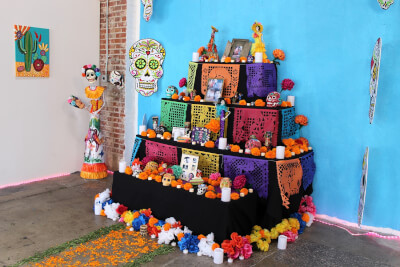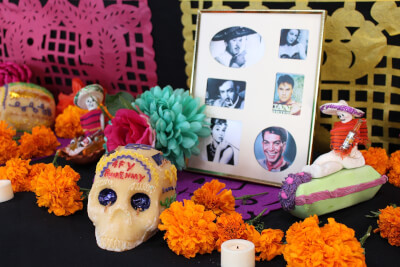
Every year at the end of October and beginning of November, while many get dressed up and trick-or-treat, Mexican and Hispanic Catholics spend three days celebrating Día de los Muertos, known in English as Day of the Dead. The holiday is meant to serve as a day of prayer and remembrance of family members and close friends who have died, stemming from Syncretic Christianity, the blending of two or more religious beliefs into a new system. Originally observed by those of Mexican and Hispanic descent, it has taken on a larger role in today’s society, especially in the heavily Hispanic city of Los Angeles.
Kathleen Gallegos, the director and founder of Avenue 50 Studio, and Carolina Arenas from Occidental College are two individuals who organized events for the holiday. According to Gallegos, it is important for the community to respect all religious and spiritual practices. Additionally, it is important to realize the distinction between Halloween and Día de los Muertos. While they occur around the same time, the two holidays are extremely different in tone, according to Arenas.
“When we celebrate our ancestors, we take ownership of our cultural heritage. Día de los Muertos teaches us respect for our families,” Gallegos said. “It teaches us to take pride in who were are and where we come from. We honor our ancestors. When we build an altar, we’re thinking fondly of all the wonderful times we spent with them. You start to feel their presence around you, making you feel less lonely.”
Occidental hosted a Día de los Muertos celebration Oct. 28, which was sponsored by the Office for Religious and Spiritual Life. The event included a traditional meal followed by mass. Nearly 15 percent of the Occidental student body is of Latinx descent, according to College Factual.
“[The Día de los Muertos event on campus] allows any and everybody who wishes to remember, reflect and hopefully reminisce on the lives of those we’ve lost,” Arenas said via email. “I’d like to think it provides the opportunity to celebrate a cultural holiday, in what would normally be a familial setting, away from home (especially for those students who are far from home).”

Additionally, Occidental College’s partner, Fountain Community Gardens, hosted a Día de los Muertos celebration on Fountain Avenue Nov. 3. In conjunction with Occidental’s Community Engagement program, the event offered activities including a potluck, face painting, altar lighting and a screening of the movie “Coco.”
Another event was the Día de los Muertos & Pumpkin Patch Festival at Tierra de la Culebra in Highland Park Nov. 2. Between 3:30 p.m. and 5:50 p.m., the Historic Highland Park Neighborhood Council hosted the festivities which included a community altar, a pumpkin patch and lots of food, in addition to activities like face painting, zine bookmaking, poetry reading and dance performances.
“Día de los Muertos speaks to the Mexican culture through the foods, the decorations and the tradition of visiting the gravesite, cleaning and decorating it,” Gallegos said. “The whole family would gather at the grave, clean and decorate, and then have a picnic with music. They’re sharing a meal with their departed. This celebration unites the family.”

The location in Highland Park is known as an “art park,” according to the Tierra de la Culebra website, where they host a variety of events, including this one, around the arroyo landscape. The park area was lined with booths of activities and vendors while families walked around. In attendance was Sofia Gutierrez, a mother who brought her five-year-old daughter. Gutierrez was wearing black pants and a black t-shirt with a Día de los Muertos-inspired print. Her daughter was dressed similarly and also had the right side of her face painted.
“It’s so great to have an event like this where I can bring my daughter and celebrate our culture and heritage,” Gutierrez said. “Being away from home can be hard sometimes, but I like being able to still celebrate the holidays I grew up on.”
The food, activities and decorations are ways for those to feel spiritually connected to loved ones they have lost, according to Gallegos. While this is the first year the Historic Highland Park Neighborhood Council hosted the event, they are hoping to continue it in the coming years, according to Gallegos.
“Since this is our first attempt at organizing this festival, we don’t know what to expect as far as crowd size, or if bringing together two distinct cultures will work,” Gallegos said. “This event is an all-volunteer effort by the community. Hopefully, if it’s a success, next year we will be able to get funding.”
Other annual celebrations of Día de los Muertos around the greater Los Angeles area took place at Forest Lawn, the Downey Theater, the Warner Grand Theater, the Fowler Museum, Old Pasadena, the Los Angeles State Historic Park and the Bowers Museum.
![]()



































